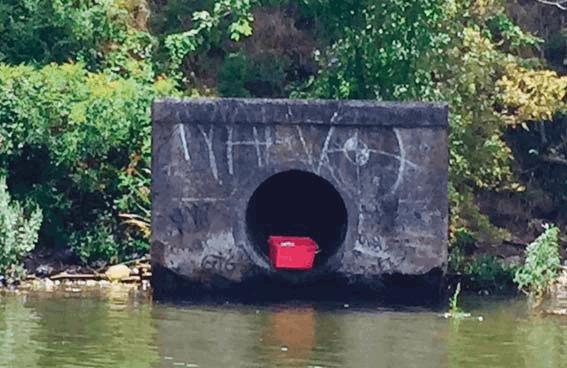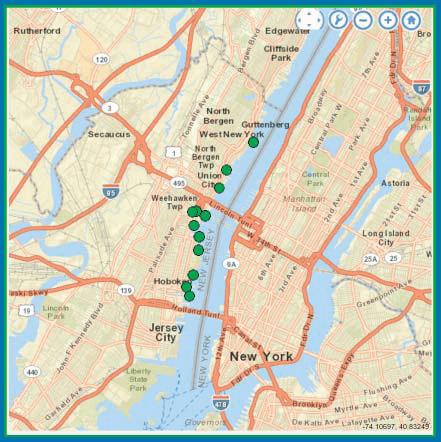Public Notice: Best Practices For CSO Alerts
By Kirstin McPolin, environmental attorney and writer
Jersey Water Works, a new collaborative, works to catalyze best practices in combined sewer overflow (CSO) reduction and notification in New Jersey.
When Emilio DeLia lived in the Country Village section of Jersey City, NJ, Newark Bay was right across the street, offering unfettered access to the lower Hackensack and Passaic rivers. Every time he put his canoe or kayak into Newark Bay, he paddled by at least a couple of combined sewer system outfalls, where sewage can discharge into waterways during rain events. He has even weathered an active combined sewer overflow, but because he is a seasoned paddler, such discharges did not stop him from going out on the river. Even though DeLia is an advanced kayaker, he knows the importance of good information in helping to keep recreational water users safe. “People have the resource of this waterfront literally feet from their homes, so public information about combined sewer overflows is vital,” he said.
There are 213 CSOs in New Jersey where raw sewage flows directly into waterways after rainstorms, threatening human health and the environment. In areas served by a combined sewer system, storm and wastewater flow through the same pipe to a sewage treatment facility, but during heavy rains some of the pipes aren’t able to handle the additional volume of water, so rather than have sewer pipes back up into homes and streets, the system sends a portion of the combined stormwater and wastewater into local waterways without its going through a treatment plant first. Contact with the untreated water can cause illnesses ranging from ear and skin infections to meningitis and encephalitis.
Required By Height Of Summer Season
In July 2015, the New Jersey Department of Environmental Protection (NJDEP) issued new permits to combined sewer system operators. The permits required that, by January 2016, public signs be posted near combined sewer discharge locations, or outfalls. All New Jersey operators have taken this first step. The permits also required that combined sewer system operators be able to notify the public of overflow events via a telephone hotline or website that can provide up-to-date information regarding CSO occurrences. These public notification systems were required to be in place by July 1, 2016.
Although public notice of CSO occurrence was required as of July 1, such notice is only as good as the data and information provided. Combined sewer system operators use any of several different types of detection methods — modeling, monitoring, or observation — to determine whether CSOs have occurred. Modeling uses predictive mathematical calculations based on watershed and rainfall information. Monitoring uses equipment installed at the outfall that collects real-time water flow information that can be downloaded and analyzed. Observation, usually employed in smaller communities, uses visual checks of the outfall done by staff.

Combined sewer outfall
New Jersey Starts To Come Online
One group in New Jersey took the lead on implementing CSO notification systems prior to the July 1 date. The North Hudson Sewerage Authority (NHSA), which serves Hoboken, Union City, Weehawken, and West New York, has 10 combined sewer outfalls along the Hudson River. The authority’s Waterbody Advisory System provides the public with real-time information related to CSOs into the Hudson River. An online color-coded map alerts the public in real time when a CSO occurs, based on level sensors in the sewer system that monitor and report overflow incidents. Each circle depicts one combined sewer outfall and changes color with the conditions: Green indicates no overflow, red indicates there has been CSO activity and serves as a warning that contact with the water within 100 feet should be avoided, and purple indicates when a monitoring unit is offline. By selecting the colored circle and clicking on the dispatch tab, users can see the status and end date and time of the most recent CSO event. “Our public notification system is real time, simple to access, and easy to understand,” said NHSA Executive Director Dr. Richard J. Wolff. “With increasing recreational activity on the Hudson River, it’s important that people know when to avoid the areas around the outfalls, and our system enables them to do just that.”
The Camden County Municipal Utilities Authority (CCMUA) has taken a different approach than real-time monitoring. It uses modeling with predictive mathematical calculations to identify under which storm conditions outfalls could be predicted to overflow. When such storm conditions occur, CCMUA will put a notification on its website warning of the likelihood of CSOs.

NHSA’s color-coded CSO map
The Passaic Valley Sewerage Commission (PVSC), which has the state’s largest wastewater treatment plant, also uses a model to predict when CSO events will overflow. This modeling is based on meteorological data. If the model shows that rainfall amounts will produce enough volume to cause a combined sewer outfall to discharge, the utility will flag the portion of the waterbody belonging to that CSO permittee as having a possible CSO event. According to PVSC, its CSO notification functionality was to be available on its website by July 1. The CSO Notification page will be accessible from PVSC’s website and the websites of the other participating CSO permittees via a link, and will be updated hourly.
Lessons From Chicago, New York City, And Washington, D.C.
In Chicago, the Metropolitan Water Reclamation District of Greater Chicago has developed a CSO Notification Plan for overflows into waterways, as required by the Illinois Environmental Protection Agency. The district maintains a list of interested parties’ emails, to which it sends alerts of CSOs into Lake Michigan. Citizens may sign up on the district’s website for these alerts. In addition, the district provides a map (updated daily) on its website that shows CSO events as a color-coded graphic with the waterways either blue (no overflow) or red (an overflow has occurred within the previous 24 hours). However, the website clearly states that the information is only updated daily, not in real time. Further, it states that not all outfall locations are equipped with monitoring equipment, so some CSOs may be occurring but not be shown.
New York has a public notification of CSOs in its CSO Wet Weather Advisory program that has been operational since January. In 2013, New York passed the Sewage Pollution Right to Know Law of 2013, which required that discharges of sewage be reported by combined sewer system operators to the New York Department of Environmental Conservation (DEC) within 2 hours and to the public and municipalities within 4 hours. On the DEC’s website, people can sign up to receive alerts by email, text, or phone, and DEC alerts them to the date and time of discharge, the location, expected duration, and the steps being taken to contain it. However, New York’s system is not without flaws; it largely relies on modeling estimates, and the alerts have reportedly been hard to sign up for.
To notify river users of CSO events, Washington, D.C. has installed CSO event indicator lights at two points: the Potomac River at Rock Creek and the Anacostia River at the South Capitol Street Bridge. When these lights are lit red, there is an active CSO event; when lit yellow, there has been one in the past 24 hours; and when unlit, there is no event. By 2025, the District of Columbia Water and Sewer Authority expects to reduce CSOs into the Potomac and Anacostia rivers by more than 95 percent. Sewer and stormwater pipes will be separated in order to eliminate several CSO outfalls and use the remaining outfalls for stormwater only.
A First Step In The Right Direction
In New Jersey, much more remains to be done to eliminate the problem of combined sewer overflows. The NJDEP permits require municipalities and wastewater treatment plants to develop, within the next four years, long term control plans that evaluate their sewage infrastructure options and propose steps to improve them. Public notification of CSO events is a vital first step.
About The Author
 Kirstin McPolin is an environmental attorney and writer. Passionate about policy and legislation, she is currently working on water infrastructure issues for Jersey Water Works, a collaborative effort of many diverse organizations and individuals who embrace the common purpose of transforming New Jersey’s inadequate water infrastructure by investing in sustainable, cost-effective solutions. When Kirstin isn’t writing, she can be found on her stand-up paddleboard with her husband and three kids.
Kirstin McPolin is an environmental attorney and writer. Passionate about policy and legislation, she is currently working on water infrastructure issues for Jersey Water Works, a collaborative effort of many diverse organizations and individuals who embrace the common purpose of transforming New Jersey’s inadequate water infrastructure by investing in sustainable, cost-effective solutions. When Kirstin isn’t writing, she can be found on her stand-up paddleboard with her husband and three kids.
